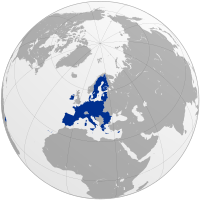
Back محكمة العدل الأوروبية Arabic Avropa Ədalət Məhkəməsi Azerbaijani Еўрапейскі суд Byelorussian Европейски съд Bulgarian Tribunal de Justícia Europeu Catalan Domstolen (øverste instans) Danish Europäischer Gerichtshof German Tribunal de Justicia (Tribunal de Justicia de la Unión Europea) Spanish Euroopa Kohus Estonian دیوان دادگستری اروپا Persian
| Court of Justice | |
|---|---|
 Emblem of the Court of Justice of the European Union | |
 Court of Justice headquarters | |
 | |
| Established | 1952 |
| Jurisdiction | European Union and Northern Ireland[a] |
| Location | Palais de la Cour de Justice, Kirchberg, Luxembourg City, Luxembourg |
| Composition method | Appointed by the representatives of the governments of the member states |
| Authorised by | Treaties of the European Union |
| Appeals from | General Court (European Union) |
| Number of positions |
|
| Website | curia |
| President | |
| Currently | Koen Lenaerts |
| Since | 8 October 2015 |
| Vice-President | |
| Currently | Thomas von Danwitz |
| Since | 8 October 2024 |
| Registrar | |
| Currently | Alfredo Calot Escobar |
| Since | 7 October 2010 |
| Division map | |
 | |
| This article is part of a series on |
 |
|---|
|
|
The European Court of Justice (ECJ), formally just the Court of Justice (French: Cour de Justice), is the supreme court of the European Union in matters of European Union law. As a part of the Court of Justice of the European Union, it is tasked with interpreting EU law and ensuring its uniform application across all EU member states under Article 263 of the Treaty of the Functioning of the European Union (TFEU).[2]
The Court was established in 1952, and is based in Luxembourg. It is composed of one judge per member state – currently 27 – although it normally hears cases in panels of three, five or fifteen judges.[3] The Court has been led by president Koen Lenaerts since 2015.[2]
The ECJ is the highest court of the European Union in matters of Union law, but not national law. It is not possible to appeal against the decisions of national courts in the ECJ, but rather national courts refer questions of EU law to the ECJ.[4] However, it is ultimately for the national court to apply the resulting interpretation to the facts of any given case, although only courts of final appeal are bound to refer a question of EU law when one is addressed. The treaties give the ECJ the power for consistent application of EU law across the EU as a whole.
The court also acts as an administrative and constitutional court between the other EU institutions and the Member States and can annul or invalidate unlawful acts of EU institutions, bodies, offices and agencies.[2]
- ^ House of Lords European Union Committee (1 June 2020). 9th Report of Session 2019–21: The Protocol on Ireland/Northern Ireland (Report). House of Lords. p. 65. Archived from the original on 31 January 2021. Retrieved 2 January 2021.
The Protocol will also confer full jurisdiction on the CJEU to oversee the operation of EU law applying to Northern Ireland in relation to customs and the movement of goods, technical regulations, VAT and excise, the Single Electricity Market and State aid; including the jurisdiction to hear applications for preliminary rulings submitted by the courts of Northern Ireland. The UK will have the right to participate in these proceedings as if it were a Member State.
- ^ a b c "Court of Justice of the European Union (CJEU)". Europa (web portal). 16 June 2016. Retrieved 19 March 2018.
- ^ "CURIA - Presentation - Court of Justice of the European Union". curia.europa.eu.
- ^ "Your questions on the Court of Justice of the European Union, p. 4" (PDF). Archived (PDF) from the original on 9 October 2022.
Cite error: There are <ref group=lower-alpha> tags or {{efn}} templates on this page, but the references will not show without a {{reflist|group=lower-alpha}} template or {{notelist}} template (see the help page).



